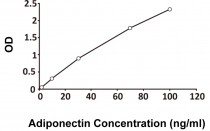ARG80823
Human Adiponectin ELISA Kit
Human Adiponectin ELISA Kit for ELISA and Human
Cancer kit; Cell Biology and Cellular Response kit; Developmental Biology kit; Metabolism kit; Neuroscience kit; Signaling Transduction kit
Overview
| Product Description | ARG80823 Human Adiponectin ELISA Kit is an Enzyme Immunoassay kit for the quantification of Human Adiponectin in serum and plasma (heparin). |
|---|---|
| Tested Reactivity | Hu |
| Tested Application | ELISA |
| Target Name | Adiponectin |
| Conjugation | HRP |
| Conjugation Note | Substrate: TMB and read at 450 nm |
| Sensitivity | less than 0.27 ng/ml |
| Sample Type | Serum and plasma (heparin). |
| Standard Range | 2 - 100 ng/ml |
| Sample Volume | 100 µl |
| Alternate Names | Adipose most abundant gene transcript 1 protein; ADPN; APM-1; Gelatin-binding protein; APM1; ACDC; Adiponectin; apM-1; ACRP30; ADIPQTL1; GBP28; 30 kDa adipocyte complement-related protein; Adipocyte, C1q and collagen domain-containing protein; Adipocyte complement-related 30 kDa protein |
Application Instructions
| Assay Time | 1 h, 30 min (RT/shaking), 15 min (RT) |
|---|
Properties
| Form | 96 well |
|---|---|
| Storage Instruction | Store the kit at 2-8°C. Keep microplate wells sealed in a dry bag with desiccants. Do not expose test reagents to heat, sun or strong light during storage and usage. Please refer to the product user manual for detail temperatures of the components. |
| Note | For laboratory research only, not for drug, diagnostic or other use. |
Bioinformation
| Database Links | |
|---|---|
| Gene Symbol | ADIPOQ |
| Gene Full Name | adiponectin, C1Q and collagen domain containing |
| Background | Adiponectin is a 30kDa protein which percentage in serum proteins is 0.01%. It is mainly synthesized by Adipocytes, but also muscle cells and hepatocytes have the ability to synthesize Adiponectin. Until now, IGF-I is the only known natural inductor of the synthesis. It consists of a Collagen-like N-terminal and a globular C-terminal domain. In vivo Adiponectin appears with different oligomers. Beside the trimer and ditrimer also high molecular multimers exist. Up to now two different receptors are known, both receptors are ubiquitary expressed, though the distribution in the tissues varies. The Adiponectin Receptor 1 (AdipoR1) is especially in muscle- and AdipoR2 in liver tissue synthesized. The significance for the human organism is not clear until now. First studies show, that adiponectin correlates negatively with BMI and thus it could have relevance for the energy metabolism for example through the regulation of fatty acid oxidation. Beside the correlation with BMI, Adiponectin level is associated with the Insulin-Resistance and so also linked with Type II Diabetes. Adiponectin is associated also with glucose- und lipometabolism. The formerly proposed diagnostic value of the high molecular weight form of adiponectin was not verified using a commercially available testsystem for the determination of HMW adiponectin. Blueher et al. clearly demonstrate that regarding the diagnosis of insulin resistance, measured by whole body glucose uptake below 40 µmol/kg*min, total adiponectin as determined with this testkit, is with an area of 0.92 under the receiver-operating curve, of greater diagnostic value. Furthermore it is involved in inflammatory processes and therewith it is of importance for appearance of arteriosclerosis and coronaritis, thus the determination of Adiponectin level in plasma could serve to estimate the risk of coronary disease. Beside this Adiponectin influences further physiological processes as for example the angiogenesis. |
| Highlight | Related products: Adiponectin antibodies; Adiponectin ELISA Kits; Adiponectin Duos / Panels; New ELISA data calculation tool: Simplify the ELISA analysis by GainData |
| Research Area | Cancer kit; Cell Biology and Cellular Response kit; Developmental Biology kit; Metabolism kit; Neuroscience kit; Signaling Transduction kit |
| PTM | Hydroxylated Lys-33 was not identified in PubMed:16497731, probably due to poor representation of the N-terminal peptide in mass fingerprinting. HMW complexes are more extensively glycosylated than smaller oligomers. Hydroxylation and glycosylation of the lysine residues within the collagene-like domain of adiponectin seem to be critically involved in regulating the formation and/or secretion of HMW complexes and consequently contribute to the insulin-sensitizing activity of adiponectin in hepatocytes (By similarity). O-glycosylated. Not N-glycosylated. O-linked glycans on hydroxylysines consist of Glc-Gal disaccharides bound to the oxygen atom of post-translationally added hydroxyl groups. Sialylated to varying degrees depending on tissue. Thr-22 appears to be the major site of sialylation. Higher sialylation found in SGBS adipocytes than in HEK fibroblasts. Sialylation is not required neither for heterodimerization nor for secretion. Not sialylated on the glycosylated hydroxylysines. Desialylated forms are rapidly cleared from the circulation. |
Images (1) Click the Picture to Zoom In
| Title | Download Link |
|---|---|
| ARG80823 Human Adiponectin ELISA Kit User's manual |
 Download Download
|






